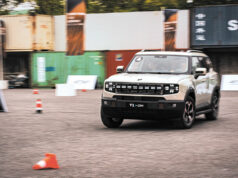OF the eight members of the Association of Southeast Asian Nations (ASEAN) that submit data to the region’s vehicle industry group, three have recorded less deliveries in the first nine months of 2018 when compared to the same period of the previous year.
According to the latest available data from the ASEAN Automotive Federation (AAF), sales of vehicles in Brunei dropped 4.8% in the January-to-September stretch in 2018, while those in the Philippines and Singapore decreased 13.8% and 16.8%, respectively. In contrast, vehicle deliveries in Indonesia, Malaysia, Myanmar, Thailand and Vietnam increased. No data regarding Cambodia and Laos, the two other ASEAN members, is supplied by the AAF.
SALES SLOWDOWN
Brunei reported sales of 8,389 vehicles in the first three quarters of 2018, or 401 less than those recorded during the comparable period in 2017. The Philippines managed 261,161 deliveries, which were 41,698 vehicles short of its nine-month tally in 2017. Singapore’s total was 70,105 vehicles, down by 14,124 units.
The dip in Singapore’s results, seen in seven of the nine months of 2018, was a result of the city-state’s cap on purchases of cars meant for personal use. Singapore’s Land Transport Authority on Oct. 23, 2017 announced the 0.25% annual growth rate specified for cars and similar vehicles during the time would be reduced to 0% by February 2018 (vehicles intended for commercial purposes are allowed a 0.25% growth rate until the first quarter of 2021). The sales cap, according to a statement posted by the government agency on its Website, was implemented “in view of Singapore’s land constraints and [its] commitment to continually improve [its] public transport system.”
The sales slowdown in the Philippines, according to the Chamber of Automotive Manufacturers of the Philippines, Inc. (CAMPI) and the Truck Manufacturers Association (TMA), was attributed to higher taxes imposed on vehicles and to rising inflation. In March 2018 CAMPI president Rommel R. Gutierrez in a statement explained the decrease seen in February — the first month vehicles sales declined in the country — “suggests that the market is still adjusting to the new excise tax regime.”
In July last year, CAMPI reported first-half sales of its member-companies (including those of TMA’s) were down 12.5% compared to the same period in 2017, or 171,352 vehicles against the previous year’s 195,772-vehicle tally. In a CAMPI statement issued with report, Mr. Gutierrez said the drop was “largely due to consumers’ prioritization of buying basic goods and services as buying big-ticket items like motor vehicles is less favorable at this time due to rising inflation, which increased to 5.2% this June 2018.”
In October 2018, when CAMPI’s and TMA’s sales tally for the first three quarters of the year became available — and which showed a 13.8% decline year-to-date — the groups expressed optimism over signs of recovery. CAMPI and TMA said they “expect a boost” coming from new model releases and purchases during the Christmas season (the groups’ sales by the end of November 2018 — the last month for which data is available — were down 14.4% from 2017).
The AAF data reflects sales reports from CAMPI and TMA and does not include those from another local industry group, the Association of Vehicle Importers and Distributors (AVID).
AVID reported in October last year that sales of its member-companies in the first three quarters of 2018 decreased 13% compared to their tally for the same period in 2017 — or 65,917 vehicles last year versus 75,949 vehicles a year before. The group’s president, Ma. Fe Perez-Agudo, in a statement contained in the same report said vehicle demand was “dampened by high inflation, interest rate hike and surge in oil prices.”
At least three auto brands report their sales performance to both CAMPI and AVID.
POSITIVE PERFORMANCES
Myanmar posted the fastest vehicle-sales growth in ASEAN; a 120.1% spike in the first three quarters of 2018 compared to the same stretch in 2017, or 11,815 vehicles last year against 5,369 vehicles two years ago.
Selling the most number was Indonesia, with 856,439 vehicles delivered during the nine-month period in 2018. The total represented a 6.5% rise from the 803,812 vehicles sold during the comparable period in 2017.

Vehicle sales in Thailand in the same nine months of 2018 totaled 746,584 units, up 20.3% from the comparable duration a year before — which stood at 620,715 units. Malaysia recorded deliveries of 454,971 vehicles, 6.9% more than the 425,678 vehicles sold in the first three quarters of 2017. Sold in Vietnam during the same duration in 2018 were 194,427 vehicles, a 5.2% increase from the 184,838-unit tally in the nine-month period of 2017.
Across all eight ASEAN members, vehicle sales totaled 2,603,871 units from January to September 2018, topping the 2,436,300-unit result for the same stretch in 2017 — a 6.9% growth.
Adding to the tally are the 7,610,826 motorcycles sold in Indonesia, Malaysia, Philippines, Singapore and Thailand during the first three quarters of last year. Of the total, Indonesia accounted for 4,722,242 units, Thailand for 1,366,100, and the Philippines took in 1,174,476 motorcycles.
Sales of motorcycles in the five countries grew 8.4% year-to-date.
PRODUCTION PROFILE
Thailand and Indonesia led in auto manufacturing in the region in the first three quarters of 2018, with both countries producing more vehicles than they sold in their domestic markets. Both countries also registered year-to-date increases in production — 8.6% and 10.2%, respectively.
Thailand built 1,604,115 vehicles, Indonesia 995,836 vehicles during the same period.
In that time Malaysia also managed a double-digit rise in production — 10.3%, representing 420, 498 vehicles in 2018 — while Vietnam manufactured 148,317 vehicles, up 1.6%. Myanmar recorded a 145.5% increase in production with 8,014 vehicles made.
Of the six Southeast Asian countries submitting vehicle-production data to the AAF — Laos and Singapore both supply the organization with sales figures, but not regarding production — the Philippines was the only one which recorded a decline in the first nine months of 2018. Vehicles built in the country totaled 62,491 units, 44.8% less than the 113,167-unit output for the same period in 2017.
The production output for all six countries reached 3,239,272 vehicles, rising 7.1% year-to-date.
Three countries reported their motorcycle production data to the ASEAN Automotive Federation for the Jan.-Sept. 2018 period, all of which saw increases. Thailand inched 0.7% up with 1,557,281 units built, the Philippines’ output rose 4.4% with 947,866 motorcycles built, and Malaysia’s total of 335,340 units built represented a 1.4% growth year-on-year.
The total output for the three countries — 2,839,487 motorcycles in the first three quarters of 2018 — was 2% more than that logged during the comparable period in 2017. — Brian M. Afuang



